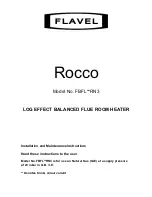
16
SNA-Series Tankless Heater
Installation
6/10/2016
Bradley •
215-1815 Rev. E; ECN 16-17-016
Maintenance
Preventative maintenance is important for optimal performance of the heater . To ensure the heater works properly,
always keep the inside of the enclosure dry . Moisture inside an enclosure increases the humidity, which condenses
on cooler surfaces . This can cause electrical problems and reduce the efficiency of enclosure insulation . To prevent
problems perform the following:
• Verify the interior of the enclosure is dry .
• Verify there are no leaks in seals of enclosure and that in high humidity environments all enclosure egresses are
properly sealed .
• Ensure plugs are in place on back side of enclosure .
•
Monitor Shower heater performance at each routine safety shower inspection.
• Verify the following lights illuminate with activation of the Shower or Eye/FaceWash:
• Green bank energized lights
• Digital display controller
• Red element load lights 1-4
• Green power light illuminated
• Verify that the heater activates the “TepidGuard” discharge port by purging water whenever the shower is deactivated . If
heater does not perform as expected, take appropriate corrective action by evaluating the cause and repair as necessary .
• Check seals monthly during temperatures above 32°F (0°C) and weekly during temperatures below 32°F(0°C) .
Check internal freeze protection system(ENHT, ENHT30) prior to first seasonal freeze for proper performance . The
external heater and internal thermostat are factory set at 55°F(13°C) . Check weekly during temperatures below
32°F (0°C) . See Information in Product Options section for additional information on freeze protection .
• Bimetal manual reset safeties mounted to the heat exchangers may trip at temperatures below 32°F (0°C) on
heaters equipped with ENHT or ENHT30 . The bimetal manual resets are set to trip at 100°F (38°C) . Heat trace
installed on connected piping can heat water to temperatures above 100°F (38°C), causing the manual reset
safeties to trip . Reset bimetal manual safeties and lower heat trace temperature to below 100°F (38°C) .
• All heaters require filtration of 150 microns or smaller to ensure proper operation . Y-strainers or additional filtration
should be verified and cleaned at least every 6 months or more often in areas where hard water sediment is
present in the water .
To clean the Y-Strainer:
1 . Turn the power off at the circuit breaker panel .
2 . Shut off the installer supplied cold water isolation valve to the heater .
3 . Relieve pressure in the plumbing lines .
4 . Position a bucket under the cold water inlet to catch any water that may still be in the pipe .
5 . Loosen the plumbing connection on the Y-strainer to get to the screen .
6 . Remove screen and clean out debris . Use a wire brush to clean smaller particles from the screen .
7 . Once the screen is clean, put it back into the Y-strainer housing and secure the plumbing connection .
8 . Before switching the power back on, bleed the air out of the lines by turning heater water supply back on and
the plumbing fixture or process farthest from the heater .
9 . With the air purged, turn on all circuit breakers supplying the water heater .
• At the same time the Y-strainer or additional filtration is cleaned, it is a good practice to also check all valves
connected to the system . With no water flow through the heater, work both the inlet ball valves and the outlet gate
valves open and shut to break up any calcium deposits that may have formed from the valve being open for an
extended period of time . Power to the heater does not need to be turned off to do this .
















































